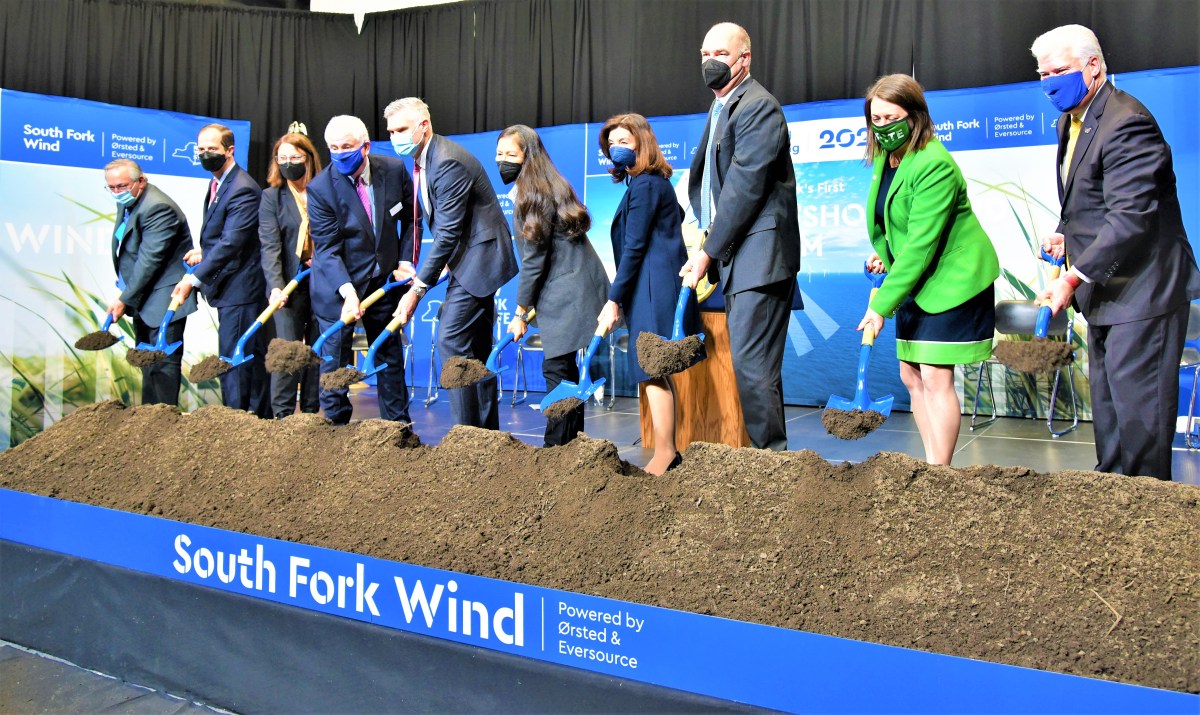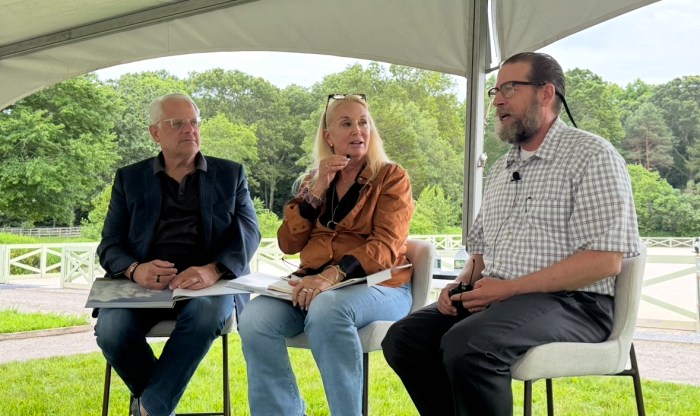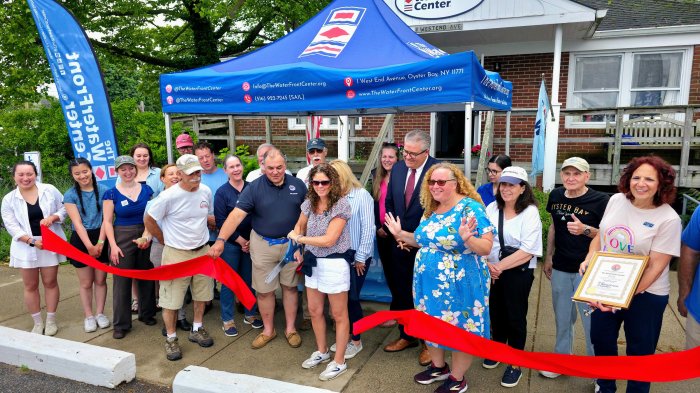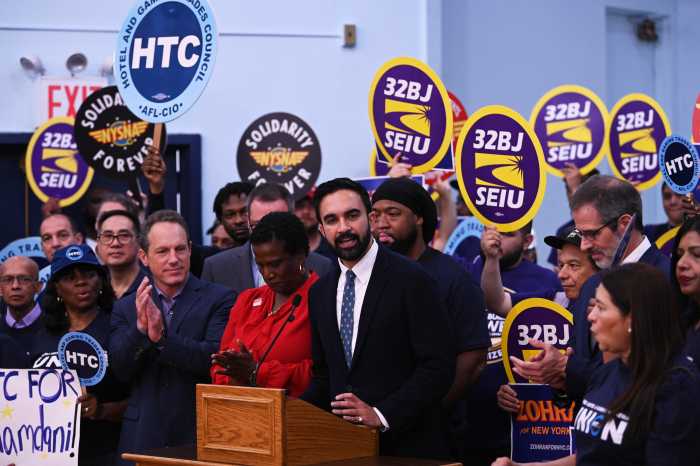After years of planning and debate, offshore wind farm developers recently took several big steps forward in a half dozen projects in various stages of development off the coast of Long Island.
A record-setting sale of offshore wind development rights last week saw combined bids for six areas off the coasts of New York and New Jersey stretching to $4.73 billion. The auction came less than two weeks after officials held a groundbreaking — or a seafloor breaking, as it were — ceremony in Wainscott on Feb. 11 to mark construction starting on the 130-megawatt South Fork Wind, the first offshore wind project in New York State.
“When you ask what the energy future may look like, I say, ‘The answer my friend is blowing in the wind,’” Gov. Kathy Hochul told the crowd gathered for the ceremonial first shovel in the ground. She apologized to Bob Dylan for co-opting his lyrics, then led the ceremony as the folk song played in the background.
Eyes across the East Coast are looking to the offshore wind farm as the future of alternative energy. Progress on the Hamptons project follows the nation’s first offshore wind farm, which went online off Block Island in 2016 and comes as Massachusetts currently is developing another.
President Joe Biden early last year set a goal to deploy 30 gigawatts of offshore wind energy — enough to power 10 million homes — by 2030. The U.S. Bureau of Ocean Energy Management (BOEM), the division of the Interior Department that oversees offshore wind permitting, will hold up to seven lease sales by 2025 in the Gulf of Maine, Gulf of Mexico, and off the coasts of California, the Carolinas and Oregon.
The New York-area sales could result in 5.6 to 7 gigawatts of offshore wind energy, which is enough to power nearly 2 million homes. Meanwhile, proponents are adjusting their sails for the headwinds the industry faces, from legal challenges to environmental hurdles.
Long Island Power Authority CEO Tom Falcone notes some regions are better politically and geographically suited for offshore wind.
“There are some projects as far down as Virginia,” he said in an interview. “The resource is better up here, the water is shallower up here. That’s the main impediment in California, where the water is deep. So they have very high renewable goals, but it’s hard to construct on existing technologies … As you go farther south, though, the resource isn’t quite as good, but also the states are less aggressive about clean energy goals. Right now there really is no federal energy policy. It’s all state by state. New York is zero carbon by 2040 … There’s no similar goal in Florida.”
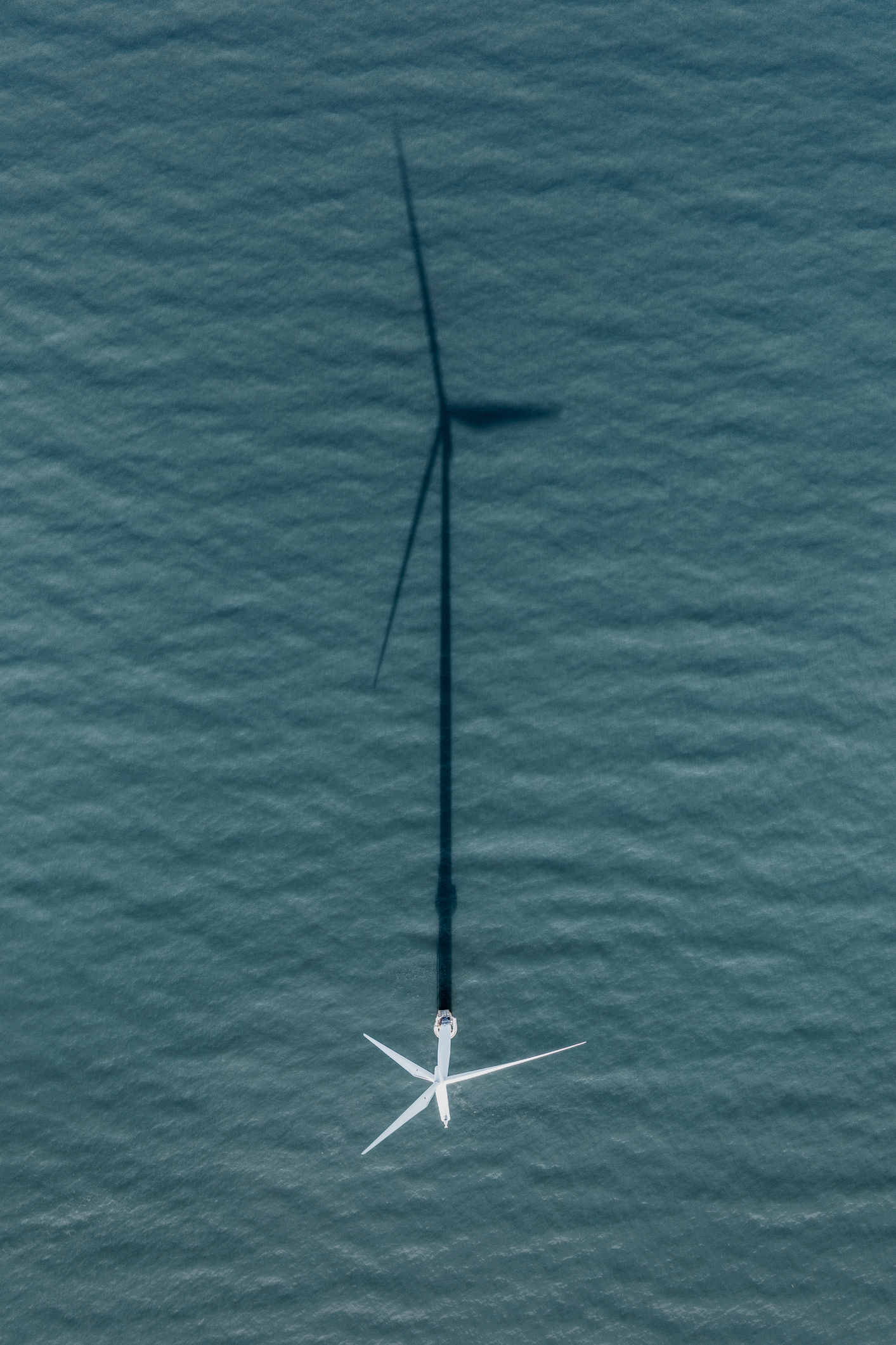
LOCAL OPPOSITION
The South Fork Wind farm’s developers, Ørsted & Eversource, who plan to build 12 turbines about 30 miles off Montauk’s coast — enough to power 70,000 homes annually — have faced legal challenges from some Wainscott residents opposed to the cable coming ashore in their community.
Citizens for the Preservation of Wainscott filed a motion in the Appellate Division of New York State Supreme Court to block the construction until the court has an opportunity to rule on the group’s appeal of the state Public Service Commission’s decision allowing the cable to run through the community. The appeals court judges rejected that motion last month, but the suit is pending.
“We continue to support the move to renewable energy and celebrate the progress toward that goal,” the group said in a statement following the groundbreaking. “But we continue to have serious reservations regarding an infrastructure project that runs its cable through residential neighborhoods, and next to a PFAS superfund site, particularly when better alternative sites were available. Our focus will continue to be on protecting our community.”
The group isn’t the only one opposed. Bonnie Brady, executive director of the Montauk-based Long Island Commercial Fishing Association, protested the groundbreaking ceremony while playing an audio recording of what she says the construction noise will sound like from on land. As officials left, she reminded them that the turbines will be built in North Atlantic Right Whale territory.
Michael Wootton, a 63-year-old semi-retired lifeguard from Wainscott, rallied alongside her.
“Wind power is a poor solution to meet peak demand in summertime,” he said, arguing that the oceanfront will be ruined forever by the construction.
Besides the marine life and aesthetic concerns, the larger issue of industrializing the ocean also proves problematic for some.
“These facilities operate on land, where people and our developments and demands for power live, along with the messes we’re created,” said Steven Resler, a retired New York State Department of State coastal manager. “They don’t belong in, on, or over the water. Where do they belong on land? Mixed with other energy generating facilities (including solar) in industrial areas, along energy generating transmission corridors outside of residential areas, along major transportation corridors such as interstate and certain state highway medians and right of ways, former landfill sites, and other areas not previously developed.”
Some environmentalists accept the plan as better than the alternative.
“As imperfect as offshore wind energy may be, our country and the world has to move off of fossil fuel consumption without delay,” says Kevin McCallister, founder of Defend H20, a Sag Harbor-based nonprofit.
He noted that some issues, such as birds being fatally struck by turbine blades, can be mitigated.
“Other than knowing it occurs, I don’t know the extent but urged [best technology available] be used,” he says. “For example, one black blade apparently reduces the likelihood of strikes significantly.”
WINDS OF CHANGE
In the bigger picture, the transition to clean energy required to prevent temperatures from rising swiftly could shave 2% off global GDP by 2050 but is likely recoverable before the end of the century, a report by natural resources consultancy Wood Mackenzie said last month.
While investments in technologies like solar and wind farms, and advanced batteries will generate jobs, the transition will also likely cause a loss of jobs and tax revenues in fossil fuel production, said the report called “No Pain, No Gain: The economic consequences of accelerating the energy transition.”
“It’s by no means a way to say that we shouldn’t pursue transition or slow it down,” said Peter Martin, WoodMac’s chief economist. “This pain in the short-term will pay off in the long-term.”
In the local contribution to that effort, BOEM’s six leases span a total of 488,201 acres between Long Island and New Jersey, an area known as the New York Bight. The sale is the largest U.S. offshore wind auction ever and the first offshore wind lease sale under President Joe Biden, who has made expansion of offshore wind a cornerstone of his plans to tackle climate change while building a new domestic jobs engine.
Following the auction, which began on Wednesday and stretched into Friday afternoon, the top bidder was Bight Wind Holdings LLC, a joint venture between Germany’s largest power producer RWE and Britain’s National Grid, which won a single 125,964-acre parcel for $1.1 billion.
Other winning bidders included Atlantic Shores Offshore Wind Bight LLC, a fifty-fifty joint venture between Shell New Energies US LLC and EDF Renewables North America, whose parent companies are European energy giants.
Other winners included Mid Atlantic Offshore Wind LCC, which is owned by a Copenhagen Infrastructure Partners fund; OW Ocean Winds East LLC, which is a joint venture between Portugal’s EDP Renewables and France’s ENGIE; Attentive Energy LLC; and Invenergy Wind Offshore LLC, BOEM said.
An offshore energy industry group, the National Ocean Industries Association, said the auction reflected optimism among offshore wind developers of strong future demand.
“The record-shattering interest in the New York Bight lease sale is testament to how bright the American offshore wind outlook is and how confident developers are in the strength of the U.S. offshore wind industry as a whole,” said Erik Milito, president of NOIA.
-With Julia Moro, Reuters, and Dan’s Papers
For more business coverage visit longislandpress.com/category/business
Sign up for Long Island Press’ email newsletters here. Sign up for home delivery of Long Island Press here. Sign up for discounts by becoming a Long Island Press community partner here.




